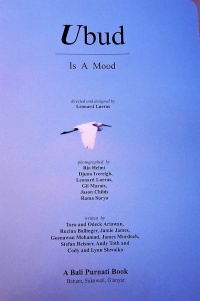Ubud is a Mood
- Title
- Ubud is a Mood
- Original language
- Author(s)
- Illustrator(s)
- Publisher
- Bali Purnati
- ISBN
- —
- Publication date
- 2004
- Subjects
- Art
- culture
- Find Book
- Related Env. Initiatives
- Related Places
- Related Biographies
- Related Children's Books
- Related Holidays
- Related Folktales
- Related Comics
- Related Lontar
- Linked words
Description(s)
an affectionate pictorial and cultural collection of essays on Bali’s cultural hub. The 14 contributing writers – among them such well-known Indonesianists, photographers and literary luminaries as James Murdoch, Goenawan Mohammed and Rio Helmi – lead us in a series of essays on a tour through the cafes, salons, warung, galleries, secret places and into the minds of eccentric personalities who loved Ubud both past and present. The history of this sprawling village in the southcentral hinterlands of Bali is a grand and engaging tale about how a sleepy rice- and herb-growing hamlet in the span of just a few decades became a world-renowned art colony – what Kyoto is to Japan and what Greenwich Village is to New York. In an erudite capsule discussion of Ubud’s art traditions and famous celebrities, Jamie James characterized the flowering of the arts in Ubud during the 1930s as “an artistic revolution unprecedented in the history of tropical Asia.” Less praiseworthy is Stefan Reisner’s brilliant chapter “Foreign Ubud” in which he calls the town “a dilapidated global village.” And there’s every opinion and stance in between. Victor Mason’s delightful piece which looks at Ubud through the eyes of several different bird species, while insights into music and dance by musicologist Andy Toth have never been published before. But this is not so much a book about just Ubud as it is a fascinating window into all of Balinese traditional and contemporary art and culture. It’s also a portrait of the town’s expat society of jewelers, restaurateurs, moneychangers, writers, rag traders, designers, artists, photographers and wits, as well as colon cleaners and wigmakers on and on. This makes Ubud is a Mood the ultimate insider’s book about “Ubudians,” as one author Rucina Ballinger calls them. Its pages are full of gossip, reminisces, anecdotes and real life tales from a generous helping of Ubud’s long-term native and foreign residents. Open it anywhere and the reader is sure to find some image, story, arcane fact or minutiae that will delight or inform.


Enable comment auto-refresher